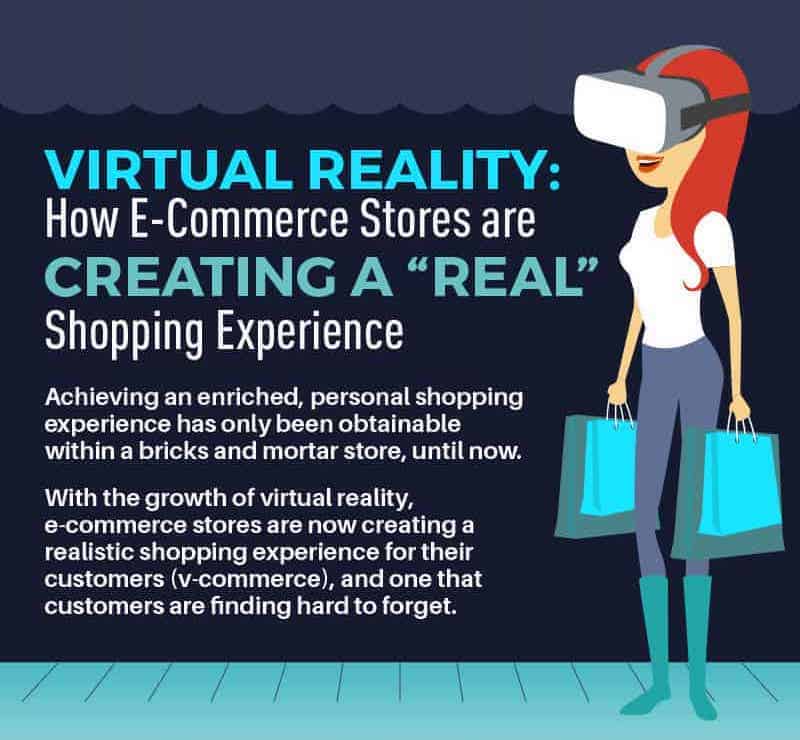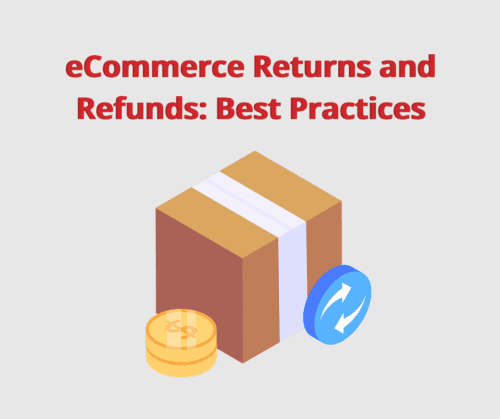Virtual reality (VR) is changing online shopping (and, as a result, the eCommerce fulfillment operations behind the scenes) by creating a virtual shopping experience that simulates the touch-and-feel experience of shopping in a store. In fact, virtual reality and augmented reality (AR) can sometimes offer benefits that you can’t get from shopping in a store, like visualizing how a piece of furniture would fit in your living room. It’s the ultimate opportunity to try before you buy; in some cases, AR and VR are more useful to consumers than a physical store.

Virtual reality allows retailers to bridge the gap between physical and online stores. VR and AR are such useful sales tools that, in this case, traditionally brick-and-mortar brands are finding ways to adapt the tech for their own uses. It can be especially helpful if you ship large items. Even with an experienced 3PL to help manage returns, it’s better if customers know heavy items will work for them.
Here are some of the ways that augmented reality and virtual reality are helping online retailers create exciting virtual shopping experiences—and how your business can benefit too.
What is virtual reality?
Virtual reality is a 3D projection that lets you feel like you are in the projected scene. Users most commonly enter the virtual world by putting on a VR headset to see and hear the virtual environment. VR can also include gloves with sensors to allow you to “touch” items in the virtual world. VR is an immersive experience that lets you move around and explore an environment as if you were actually there.
What’s the difference between VR and AR?
VR replaces the world around you with a virtual environment. Augmented reality adds virtual objects to the real world. The most famous example of AR is the Pokemon Go game, which placed virtual Pokemon characters in the real world around you.
Augmented reality is a useful tool for eCommerce companies that sell products to augment the home. Online furniture retailer Wayfair is leveraging AR to allow consumers to see how a bed or chair will fit into their home virtually.
One of the most significant differences between AR and VR is accessibility. Users need dedicated hardware to surround themselves with virtual reality, but they can take advantage of augmented reality with the camera on a smartphone or tablet—no special equipment needed.
AR doesn’t offer the same immersive experience as VR. You can’t simulate touch and feel in AR the way you can in VR. But both technologies have their uses in eCommerce.
Create unique shopping experiences through virtual reality (VR)
About 26 million US households own a VR device. That’s less than 10% of the population, but people are rapidly adopting VR technology, and it continues to become more common. Augmented reality can reach a much broader audience. Which tool you choose will depend on the products you sell and the experience you want to offer shoppers.
Let customers try products via virtual reality eCommerce
One of the most significant challenges for eCommerce is that consumers have to buy products without examining them first. That’s why eCommerce returns are so vital to success—the promise that a customer can easily return an item that doesn’t meet their expectations gives them the confidence to click the Buy button.

Virtual reality offers the opportunity to bridge this gap, at least in part. When you create a VR shopping experience, your customers can examine a product from all sides and even simulate the feeling of holding or using the item.
Another advantage of VR is that it provides the opportunity to build an enhanced shopping experience. In a brick-and-mortar store, a retailer can draw customers in by creating an appealing environment with fun music and dynamic product displays.
With VR, you can do more than show your products. You can place them in a virtual environment that visualizes how your customers can use them. You can also build the aspirational world that consumers can enter once they buy your product. VR can be used to enhance in-person shopping as well as eCommerce.
Use augmented reality to bring your products into your customers’ homes
The most common use of augmented reality is to project items into the environment around you. This saves people from having to guess whether and how products will fit in their homes. At the same time, AR gives eCommerce furniture sellers an advantage that most brick-and-mortar stores don’t have. You can’t sit on the new couch, but you can get a preview of how it will fit into your living room. Will the couch be too big or small for your space? If you buy it in yellow, will it match your drapes? How about in gray?

At the moment, most VBR and AR shopping experiences are bespoke environments created by large retailers. However, software like Appypie are putting these tools within reach of more and more eCommerce businesses.
Consumer attitudes about VR
Virtual reality does more than allow you to explore products. In one survey, 37% of respondents wanted to use VR as part of their travel planning. Imagine being able to walk around several different travel destinations virtually before booking a trip.

The survey found that gaming was the primary interest for a third of the respondents. That’s not surprising since gaming was one of the first industries to embrace VR and is still the primary virtual reality space.
The survey found that 80% knew about VR and 79% wanted to use it, whether they currently had VR equipment or not.
Another survey found that consumers believe VR shopping is the future. Two-thirds want to shop using virtual reality, and 63% expect VR experiences to become increasingly available to them. Promisingly, 35% told the researchers that VR would make them more likely to shop online.
Three case studies: VR done right
The list of retailers using VR or AR apps to help shoppers pick out products continues to grow. Target, Home Depot, and Amazon have created AR apps to help you shop. Makeup retailer Sephora lets you try out lipstick colors on your phone, and Nike will project a pair of shoes onto your feet to help you shop.
Here are three retailers that adopted virtual or augmented reality early and have done it well.
IKEA Place

The IKEA Place app lets you furnish your physical space with virtual pieces from the Swedish furniture maker. The AR app is a great way to overcome resistance and help people feel comfortable before making a purchase that they will need to spend hours putting together.
Audi virtual test drive

When you go to a dealership for a test drive, you get to try out the models that are in the lot. Test driving a different model doesn’t necessarily help you decide what options you want for the car you will ultimately purchase. Audi has solved this problem with a VR showroom that lets you virtually test drive the vehicle of your dreams with all the bells and whistles installed.
Shopify AR

Shopify is not just the biggest eCommerce platform; it’s also one of the most innovative. Shopify AR gives sellers the option to add augmented reality to their Shopify stores. You’ll need to use a Shopify theme that supports 3D imagery and upload 3D models and videos of your items. If you don’t have the technical chops, you can hire an expert through Shopify to add AR to your online store.
Virtual Reality Shopping FAQ
Is VR shopping a thing?
VR shopping is a thing. Many top retail brands, such as Bloomingdale’s, Ralph Lauren, Chanel, Tommy Hilfiger, Lacoste, and Pinko, have created virtual reality stores, features, tools, apps, and / or VR ecommerce shopping experiences. Many of these brands are fashion or clothing brands, as these types of businesses are well-positioned to take full advantage of VR. Brands, such as those selling glasses, like Warby Parker or Sunglass Hut have used virtual reality technologies to build virtual try on apps to aid shoppers in trying on products to see how they would look if worn in real life. Shopify augmented reality is also a thing! In fact, Shopify has dedicated an entire page listing brands that are using Shopify AR, which include: Instant Pot, Pure Cycles, All Birds, Nomatic, and Treat a Dog.
How can VR be used in shopping?
Virtual reality can be used in a number of different ways in shopping:
- To try on products such as glasses or clothing to see how the actual product would fit or look in real life.
- To shop in a fully immersible 3D environment, or virtual reality mall.
- To view products from all sides and angles, as one might as if the item was picked off of a shelf and handled in real life.
- To receive assistance from customer support in the form of AI avatars or real people who have their own avatars, which is much more personable experience than shoppers interacting with chatbots.
- Haptics, and other new technologies can make it possible to deepen the VR experience through more of the five senses, such as smell, feel (texture), or taste (imagine tasting your favorite ice creams in VR!)
- Art galleries may now showcase art in a VR art gallery, where shoppers can experience artwork at a much closer vantage than they could in the actual gallery.
- Home Depot augmented reality apps help shoppers visualize how products would look in their home, giving users the ability to see if home products match the space, or fit where customers want to place them in the home.
What is a virtual shopping platform?
The concept of a virtual reality shopping platform is still evolving, but as of 2023, a VR shopping platform is a platform built by leading technology vendors, such as obsessar.com or emperiavr.com, that can be customized to enable shopping experiences in virtual reality, whether this is in-store or online in an immersive 3D shopping environment.
How can VR and AR boost your online shopping experience?
It’s well known that videos of products in use will boost sales. Virtual reality and augmented reality are the next steps toward creating an online shopping experience that approximates—or even surpasses—brick-and-mortar browsing. How will you harness VR and other high-tech innovations to drive your eCommerce sales?
Whatever you need to grow your business, a good rule of thumb is to ask your order fulfillment company. Whether you need kitting and assembly services, help with inventory management, or someone to bounce your augmented reality ideas off of, Red Stag Fulfillment is here to help. When we can leverage our eCommerce and fulfillment experience to help our clients grow their businesses, we consider that a win.











